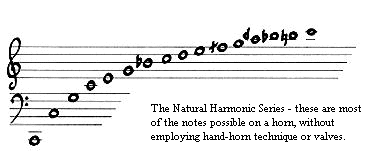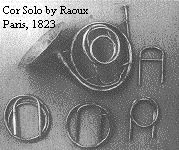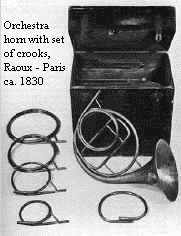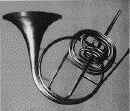 |
A Brief History of Horn Evolution
2. Crooks and Hand Horns
Beginning with the cor de chasse (French for hunting
horn), the horn began its evolution into a refined concert hall instrument. From early
beginnings in stage settings depicting the hunt, Baroque composers began writing more
complex and artistic music for this horn. Yet, the corno da caccia (Italian for
hunting horn), was still a single, fixed length of tubing and its musical potential was
limited to the natural harmonic series.

The most useful range for melodic writing was in the upper harmonics (the
"clarino" range) where the natural harmonics are close together. It was still
necessary however to switch horns if a composer wanted the hornist to change keys. The
impracticality of this soon led intelligent horn makers in the early 1700s to the
invention of the crook.
The crook was simply a section of coiled tubing that, when inserted into the horn would
change the overall length of the instrument. Changing the length would also change the
pitch (the longer the tube, the lower the pitch), allowing the same entire harmonic
series, but now, in a different key. Instead of carrying many instruments in different
keys, horn players would only have to carry one horn with a set of crooks of varying
lengths. They could change the key of the instrument simply by inserting a new
crook.
Hand horn technique -
It wasn't just the instrument that was evolving though. The players were getting
more clever as well. By 1760 a new technique in playing had firmly caught on that was
taking the horn to the next step in its evolution. The Bohemian virtuoso hornist in
the court of Dresden, Anton Hampel (1711-1771) is generally credited with developing and
teaching the technique that had been known by some hornists as early as the 1720s.
Quite simple really: by manipulating the right hand inside the bell of the horn, he could
play tones other than the natural harmonics, thus filling in the gaps between the notes of
the harmonic series.
Coupled with the use of crooks, this new "hand horn" technique opened up
exciting new possibilities for musical expression, and composers of the Classical Period
eagerly embraced it.

|
The Cor Solo and the Waldhorn were among the first instruments designed
for hand horn technique. The Cor Solo was still somewhat limited in its range of keys
though, as in the case of the cor solo pictured left - it has attachments for only G, F,
E, Eb and D transpositions. The Waldhorn had a similar system - a master crook producing
the highest key needed, and optional successive crooks, each adding more tubing, to
produce harmonics for lower keys. |
 |
It wasn't until Anton Hampel encouraged a Dresden instrument maker,
Johann Werner, to construct a horn with detachable crooks for BOTH the mouthpipe and the
middle of the horn that a full range of transpositions was possible on one instrument. The
Orchestra horn, as it was called, was honed and perfected between 1750 and 1755. With
the Orchestra horn (pictured left), all transpositions are possible, from Bb basso to Bb
alto. And utilizing hand horn tehcnique, it could now play a full chromatic scale in
any key. The horn was no longer a "special effect," but was firmly
established as a refined musical instrument, and had become a regular member of the
symphony orchestra (which was also beginning to grow as other instruments were added). |
The horn had even become a solo instrument for which Haydn wrote two concertos, and
Mozart wrote four.
Hampel was regarded by some as the "father" of the horn as a musical
instrument because of his cultivation and teaching of the hand horn technique. A new era
of musical artistry blossomed from his contributions. Hampel's most outstanding pupil,
Johann Wenzel Stich (1746-1803), also known as Giovanni Punto, became a virtuoso horn
soloist of great reputation in Europe. Not only did Punto compose his own original pieces,
but he also inspired other composers, such as Mozart and Beethoven, to compose great works
for the horn.

|
Although the Orchestra horn was a marked improvement in horn
technology, it still had some significant drawbacks. To change keys, the player still had
to stop playing and change crooks. And it was cumbersome to carry around all of the
necessary crooks. To accommodate these concerns many ideas came about - including an odd
instrument that was thought to be the answer. |
Omnitonic Horn
by Charles Sax
Brussels, ca. 1824 |
 CONTINUE... CONTINUE...
|
This is hornplanet.com
HOME
|| HornPage | St. Louis Brass | Opus 90 | Bacon | Golden Horn
|
Store | Food
|| CONTACT
 |
Copyright © Thomas Bacon
1996 - 2009
All rights reserved |
Site Design by Horndog
www.horndoggie.com |

|
|